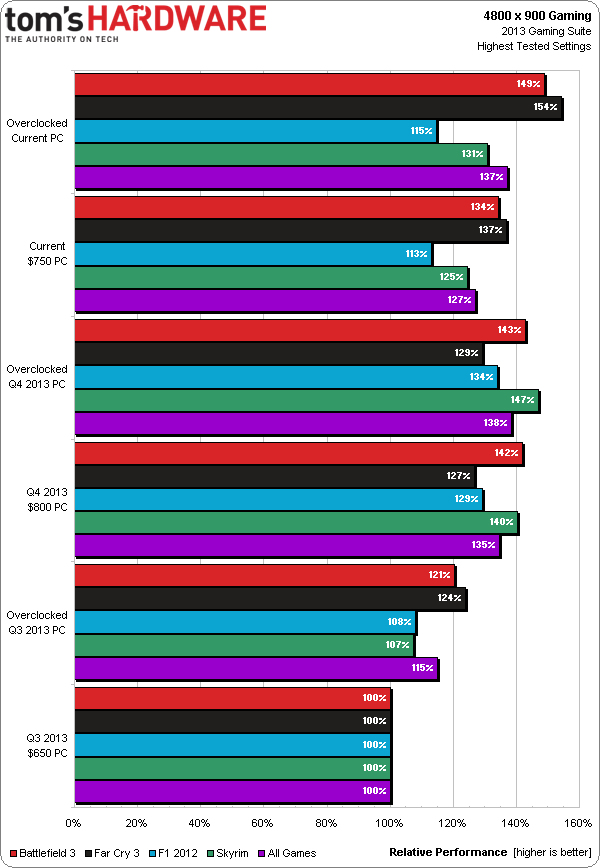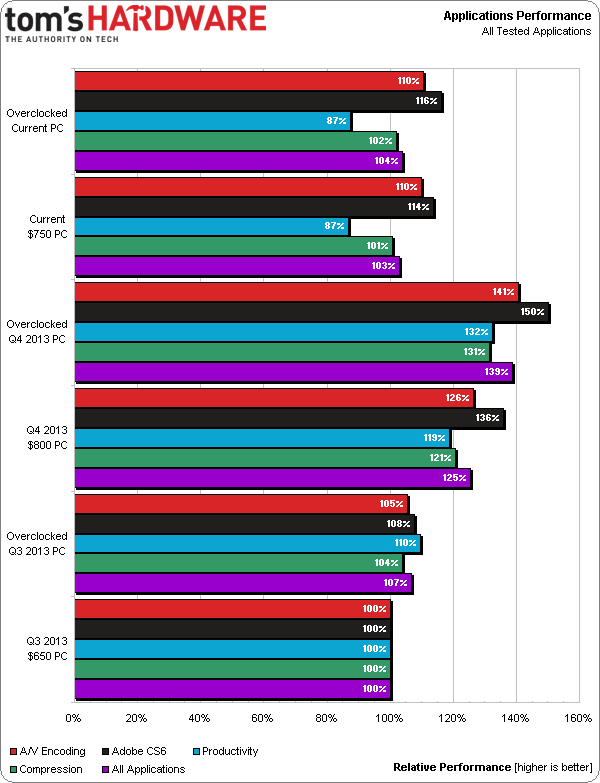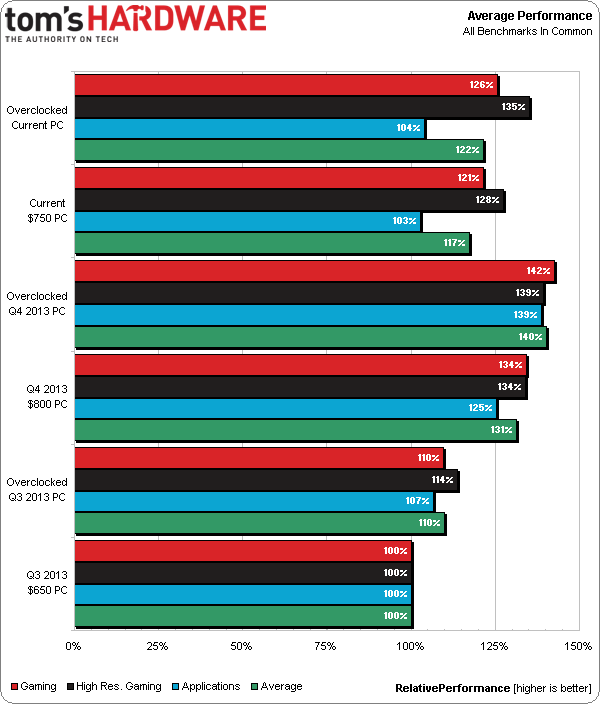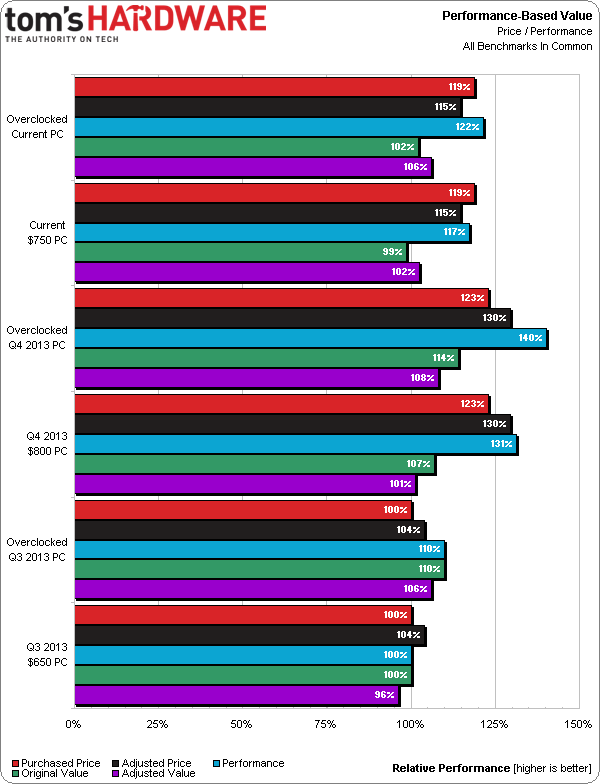System Builder Marathon, Q1 2014: The $750 Gaming PC
Summarizing The Performance Of Three Gaming Builds
That was a ton of data spanning six months worth of benchmarking. So, let's finish up by comparing three gaming-oriented builds to each other.
Given the ongoing relevancy of the $650 machine, I'll use that as our baseline and factor in only the four titles tested throughout 2013's System Builder Marathons.
Tallying average frame rates using every resolution puts a big emphasis on CPU performance. The Q1 2014 PC drops its processor budget by almost one-third, which would seem scary. And yet it still serves up at least 90% of the Core i5-equipped rig’s frame rates in three titles. It only trails further behind in F1 2012.
The more affordable $650 PC takes a hit in CPU- and GPU-limited scenarios, but its Achilles heel is The Elders Scrolls V: Skyrim. You just have to keep in mind that it was still going strong using the Ultra preset, never dropping below 50 FPS at 1920x1080.
But nobody builds a machine this strong to game at 1280x720 with low-quality details and jagged edges. So why even run those benchmarks, which mess with the averages? The data points do serve a purpose; they let us identify bottlenecks and gauge the potential of other subsystems. We can factor them out of our calculations, though, and draw conclusions about the resolutions and settings that matter most to gamers.
Cranking up the eye candy at 1920x1080 obviously shifts demands over to graphics hardware, and once we overclock the GeForce GTX 770, this quarter's PC trades blows with the more expensive rig. If we dropped F1 2012, which never dropped below 72 FPS anyway, today's effort actually matches the $800 build’s overall frame rate measurements in stock and tuned form. Performance across three panels is pretty darned strong, too.
Remember, even the $650 box survived 1920x1080 in all four games at Ultra details. The respectable overclocking headroom of its GeForce GTX 760 gave us higher GPU Boost clock rates when we needed them. But when it came to 4800x900, quality had to suffer in the name of smooth game play.
Sandwiched between the two previous machines in cost, my Q1 2014 setup delivers great frame rates in most modern titles. Of course, that was the goal all along; my hardware choices reflect the tough decisions needed to push 1920x1080 and taxing image quality options.
But the System Builder Marathon tends to illustrate overall system performance with a ton of other tests, too.
In threaded workloads, AMD's six-core FX-6300 is more capable. But the Haswell architecture's ability to get more work done per clock cycle, along with the GeForce card's solid OpenCL compute performance, means today's platform is roughly on par...at least until overclocking is taken into consideration, too.
These are gaming machines, first and foremost. So I weigh their overall performance accordingly, rather than using the same formulas Thomas will use tomorrow. On Day 4, my PC is undoubtedly going to struggle. Its gaming aptitude will only account for 20% of its overall rating. And although it doesn't quite hang with the $800 machine in today's evaluation, it slides in ahead of the cheaper system.
The two Intel-based PCs are between 56% and 71% more efficient. Overclocking both GeForce cards reduces overall efficiency compared to the stock configurations, too. While our current PC is the overall winner, we can't forget that it's driven by a pricier 80 PLUS Gold-certified power supply.
Value: Is There A Winner?
I only chart value when it’s difficult to pick a bang-for-the-buck winner through an easy calculation. This time, I have to admit that true value gets more subjective, depending on your specific needs. Even picking the right price to use in a comparison is tough, since the numbers are changing on a daily basis. We paid $300 for a Radeon R9 280X last quarter, which then shot up to $420 by the time my story went live. When it came time to order the parts for today's PC, 280Xes were still going for $420 and up. Now, the cheapest 280X in stock is $340. And the Zotac GeForce GTX 770 I used is bouncing up and down between $330 and $350.
My three PCs originally cost us $650, $799, and $773. Now, with some minor substitutions accounting for in-stock alternatively, they're closer to $685, $857, and $779. But I can almost guarantee they'll change again depending on the day you read this. Any attempt to lock in a price is futile.
I'll gauge value on two factors, then. First, the original purchase price of the components, which was set in stone, and then based on an adjusted platform price. All three builds were outfitted with 8 GB of affordable DDR3-1600 and the same 1 TB hard drive. Every time, I grabbed the most affordable DVD burner I could find and relied on bundled CPU heat sinks. All three machines could get by with the same case and power supply, which typically sold for about $45 each. Those parts are a matter of personal preference, so a fixed $235 covers the basic memory, power, storage, and case. From there, I add the cost of what really separates the platforms: processor, motherboard, and graphics. The adjusted prices come in at $675, $842, and $745.
Using only the 2013 test suite, I originally got the most value from the $800 PC in stock and overclocked form. The $650 build even slightly edges out today's effort. Of course, we can't forget that the current machine is penalized by $55 in mark-ups from the RAM, storage, optical drive, and chassis that I picked.
When we use current pricing and level out the playing field with complementary components, the current Core i3 and GeForce GTX 770 combination secures a narrow value victory right out of the box. However, all three builds are within 2% of each other once I overclock them. I don't think we can pin down a definitive winner; this is as close as you can get.
Current page: Summarizing The Performance Of Three Gaming Builds
Prev Page Power Consumption And Temperatures Next Page Did I Achieve My Goals, Or Is This A Failure?Get Tom's Hardware's best news and in-depth reviews, straight to your inbox.
-
blackmagnum This is the everyday Joe sort of gaming PC... cheap and workable. Why not Core i5 quad-core?Reply -
hmp_goose "The games we just added are unquestionably less processor-bound." This sounds like a major oversight, I fear …Reply -
ingtar33 nice build, and a good example of how even modern multi-threaded games are STILL at their heart primarily single or dual threaded games. We see this in BF4 most clearly, as the advantage of MOAR CORZ vanishes once you pass the 3rd core on the cpu... meaning a dual cored and hyperthreaded intel is still a viable gaming option; and though you can get an fx8320 for the same price as that i3, almost nothing truely makes use of 8 cores yet. I say yet, because the next gen game consoles will force games to become truly multithreaded in the future. Purhaps down the road the old piledriver chips will start to look like a great gaming value, but the situation today is still largely the same problem facing AMD 3 years ago... which is games simply don't really need MOAR CORZ. Not really anyway. I'm sure some people will have issues with using an i3, but really i think it was a fantastic read; and quite informative. Its important we keep things in perspective... and as things stand now you really don't need much more cpu power then a dual cored pentium or i3... or i guess quad core phenomII or piledriver fx.it all comes down to what you can afford to build around it.Reply -
lostgamer_03 The i3 was a bad choice, why not get an i5-3330 which is about the same in price and it offers 2 more fully enabled cores, which really would help in applications and the 'newer' games.The MOBO would also be cheaper as it is last gen.Reply -
de5_Roy the psu was a smart choice for the case, imo. modular cabling prevented the usual clutter seen in cases like these. the resulted unusually clean look of the inside. 80+ gold efficiency is also welcome. i don't think clean cable management can be measured in charts, but it's an added bonus.Reply -
pauldh That's what I thought too de5_Roy. Modular and 80 PLUS Gold was well worth spending an extra $15.Reply -
bemused_fred ReplyThe i3 was a bad choice, why not get an i5-3330 which is about the same in price and it offers 2 more fully enabled cores, which really would help in applications and the 'newer' games.The MOBO would also be cheaper as it is last gen.
When I first saw the parts list for this build, I expected myself to be in full agreement with you. I mean, can you imagine someone suggesting paring a GTX 680 with an I3? Ludicrous. They'd be laughed out the forums. However, looking at the benchmarks for the highest settings in 1920x1080 and 4800x900, I found there were 2 types of results
1. Those where the I3 and the GTX 770 build beat, or were within a few FPS of the I5 and R9-280X build:
Battlefield 3
Battlefield 4
Arma 3
Far Cry 3
2. Those where the I5 and R9-280X beat the I3 and GTX 770 build by a significant margin, but where all frame rates were well above 60FPS:
F1 2012
Grid 2
Skyrim
So, while overall performance percentage charts might put the I3 and GTX 770 behind the I5 and R9-280X behind in certain games, in a real-life setting, it seems that the I3 and GTX 770 is an equally good build. Which is really not what I was expecting.nalmost nothing truely makes use of 8 cores yet. I say yet, because the next gen game consoles will force games to become truly multithreaded in the future.
Citations desperately needed. The XBOX 360 had 3 hyper-threaded CPUs and the PS3 had a 7-core cell CPU, but this didn't push PC games during this period beyond dual cores. Indeed, as late as January 2012, Tom's hardware was finding it impossible to recommend any Quad-core AMD processors over intel Dual-core processors and as late as December 2012, dual-core Intel pentiums were taking the low-end recommendations, as they were still better at gaming at this point than 4-core AMD processors. Indeed, it wasn't until February 2013 that they reversed this recommendation, so any assumption that consoles having more cores will result in P.C. games using more cores doesn't really stand up to scrutiny, I'm afraid. -
pauldh ReplyThe i3 was a bad choice, why not get an i5-3330 which is about the same in price and it offers 2 more fully enabled cores, which really would help in applications and the 'newer' games.The MOBO would also be cheaper as it is last gen.
As explained on page 1, the whole idea here with this build was to spend less on the platform, more-than covering the premiums on graphics, RAM, and ODD vs. our last purchase.
Sure we'd go i5 if priced the same. But the -3330 is $60 more @ $190, just like the -3470 used last quarter. The -3350P saves $10 off that. H61 doesn't save much, starting $5-10 below H81, and then we'd give up capitalizing on the i5's limited overclocking. -
pauldh @bemused_fred - Yes, exactly! Good post.Reply
I was surprised to see i3 didn't yield any meaningful drop in minimum fps, at all! In fact, minimums often appeared GPU-bound, and the new GTX 770 rig won out, especially OC'ed. System bound at 70+ fps and up full-time in Skyrim or F1 2012 is hardly a loss, but an extra 3-8 fps consistently down low in ARMA III and Far Cry 3 could come in handy.
-
redgarl CPU choice is really overated with a single graphic card. The conclusion proves it. I would even stretch to go AMD to cut some money to fetch up two 750ti-760 GTX or 2 R7 graphic card.CF or SLI of two low tier graphic cards provide really good performances for a budget.Reply







